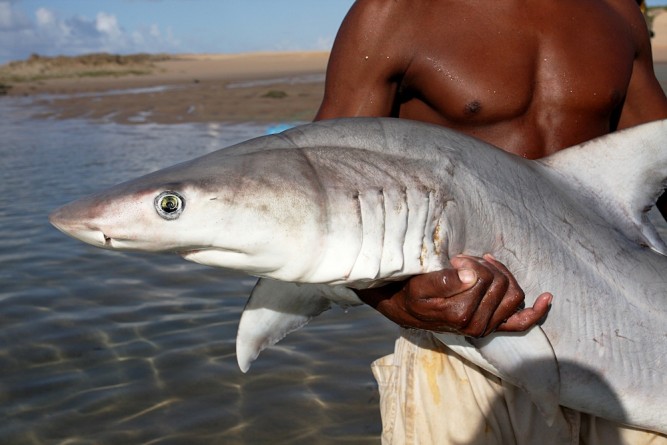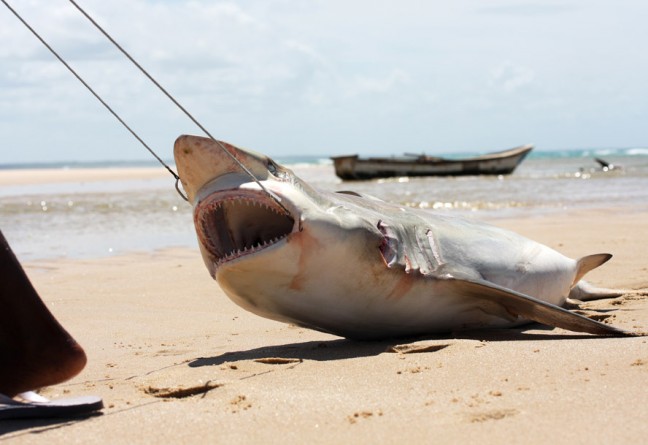I’ve never been one much for religion. If I had to kneel before anyone though, it would be David Attenborough (interview: Sir David Attenborough on Africa). My childhood was spent day dreaming my way from one of his jobs to the next. And then one day, after devouring a few too many nature documentaries, I left London and headed to the Kruger’s Wildlife Film Academy.
From film school, wet behind the ears, I left for Tofo in Mozambique, where I joined up with Dave Charley and Chris Scarffe, two British filmmakers, who were shooting a documentary on Mozambique’s shark finning crisis, Shiver (watch the trailer for Shiver here). During filming we spent long periods in remote areas, living in rural shark fishing communities. It was there that we got to know the shark hunters. Despite their demonic reputation amongst certain conservationists, we got to know beautiful souls, who were simply doing all they could in order to make ends meet.

The crew start work early. Photo by Aaron Gekoski
Shooting during Mozambique’s summer months was particularly hazardous. The sun, sea and sand battered our equipment as we filmed the sharks’ struggle for survival, day in, day out. On one filming trip, however, it was nearly me that got snared.
Entangled in Mozambique’s shark nets
It was a particularly rough day at sea. The sky cackled ominously ahead, as white caps rocked our small wooden vessel. The fishermen were in no mood to hang around so we could get the perfect shot. Carlos and I flung our kit on and dived in to inspect their nets. More than 200 metres of relentless blue rope was dotted marine life, twinkling shards of contorted silver. Some; a Spanish mackerel; a small school of king fish; a couple of trevallies; were lifeless. A devil ray pulsed in its death throws.
But it was one specimen in particular that caught our eye. At a depth of around 15 metres was the unmistakable shape of a dead shark. It hadn’t gone without a fight, its gills had been lacerated, its head twisted violently in the nets. I filmed the presenter, Carlos, as he rolled the carcass around his hands. We gesticulated to each other: what was this peculiar shark, with its large fins, streamlined body and prominent teeth?
Suddenly, the shark surged upwards. The fishermen had started hauling their net in. Fins, camera, regs, mask – anything that stuck out became entangled. Thoughts became scrambled. Despite having hundreds of dives under my belt, I was that ‘panicked diver’ those PADI chaps tell you about during Open Water studies. The urge to pull my reg out and bolt to the surface was overwhelming. But bolting from this net wasn’t an option.
I began hyperventilating. ‘Calm down. Breath. Pull your knife out and cut yourself free.’ My brain finally responded to the situation with logic. With my only free limb, I reached towards my Scubapro dive knife, which was strapped to my ankle. Jabbing at it with my fingers, I eventually hit the ‘quick release’ button, before raising it above my head and slashing at the net like a character from a horror movie. In great stabbing motions I managed to cut away enough net to release my tangled appendages. It wasn’t the most systematic approach, but it was affective.
With bits of cut net hanging off my equipment, I turned my attentions to Carlos. However this tough Mozambican had torn his way to freedom with his bare hands. With wild eyes we signalled to each other: it was time to end this dive. The whole scene probably played out in less than 30 seconds, but it felt like hours. It was a brief, terrifying, fish-eye view of what happens to millions upon millions of marine animals every day.

The dead shark before it's driven away for tests. Photo by Aaron Gekoski
Back onboard the safety of our boat, the crew seemed more concerned with the intriguing shark than our brush with death. The fishermen appeared particularly excited. “Muito grande!” they exclaimed – dollar signs in eyes – pointing at the shark’s dorsal fin. They were a little less impressed when their chopped up net emerged.
We drove the stinky carcass back to Tofo to be examined by shark and ray expert Dr. Andrea Marshall, who performed an (even stinkier) autopsy. It turned out to be a fossil shark, commonly known to as a snaggletooth weasel shark – a particularly apt name for the aesthetically-challenged fish.

Many fishing communities stopped eating contaminated meat due to the film. Photo by Aaron Gekoski
Filming continued without any mishaps and the documentary, which is still shown on Mozambican television today, was a huge success. Returning to the fishing camps after it’s release, we learned the community had stopped eating shark meat as a result of information contained in the film on the toxicity of shark meat. It was a small victory, but – given the relationships we’d formed with the fishermen and their families – a particularly poignant one.
We are currently raising funds to shoot a documentary on Madagascar’s shark crisis (crisis as in there are none). Their problems make Mozambique’s look like a mere drop in the ocean. One thing’s for sure – a dive knife will be the first item on my kit list.
Aaron Gekoski is co-owner of Ecomentaries, a media and production company that specialises in conservation/marine filmmaking. Learn more about Aaron’s photography and writing here.

















